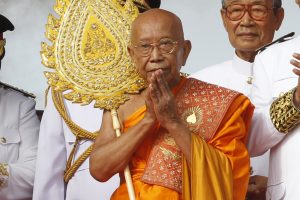Tep Vong, the senior monk who headed Cambodia’s Buddhist hierarchy and played an important role in its revival of Buddhism in the aftermath of the rule of the murderous Khmer Rouge in the late 1970s, has died. He was 92.
In a statement yesterday, The Associated Press reported that Cambodia’s Ministry of Cults and Religions said that Tep Vong, who headed both orders of Theravada Buddhism in the country, had died yesterday at Wat Ounalom, a temple in the capital Phnom Penh where he served for many years. He was admitted to Calmette Hospital last month, with undisclosed health issues.
Granted the title of Great Supreme Patriarch in 2006, Tep Vong had a close political relationship with former Prime Minister Hun Sen and his Cambodian People’s Party (CPP) during his more than 38 years in power. In a statement yesterday, Hun Sen, who visited Tep Vong in hospital on February 17, paid tribute to the senior monk.
“Your death is the loss of a great monk, the great son of the peasant who used to join the national liberation movement, and build pagodas to promote the revival of Buddhism in the Kingdom of Cambodia from the day of liberation on January 7, 1979 until the day of your death,” the former leader said, according to a report in the Khmer Times.
Born in Siem Reap province in 1932, Tep Vong played an important role in the recovery of Buddhism in Cambodia after the murderous rule of the Khmer Rouge (1975-1979), which attempted to eradicate organized religion and transform the country into a pure agrarian utopia. In September 1979, eight months after the Khmer Rouge was overthrown by the Vietnamese army, he was the youngest of seven Khmer monks who were ordained in Vietnam and became the nucleus of a new Buddhist hierarchy.
The roots of the new sangha grew entwined with those of the CPP, then known as the Kampuchean People’s Revolutionary Party (KPRP). As the scholar Ian Harris wrote in his 2008 book “Cambodian Buddhism: History and Practice,” the seven newly ordained monks were “held in high regard by the new party apparatus, and most went on to assume high-profile roles at the interface between church and state.”
The Buddhist monkhood had always been adjacent to politics, but Harris argues that after 1979 these connections were made more explicit than ever before. Monks sat on the Central Committee of the KPRP and were given other political posts. In 1981, Tep Vong was serving as vice-president of the National Assembly and was appointed chief of a unified Buddhist order that dissolved the division between the Thommayut and Mahanikay, Cambodia’s two Buddhist orders.
Since then, Tep Vong has been staunchly loyal to the CPP, overseeing a monastic hierarchy that has sanctified the government’s actions and discouraged political agitation within the sangha. This has often prompted tensions with younger members of the monkhood, who were historically active in anti-colonial and nationalist struggles and have also played prominent roles in opposition politics since the early 1990s. For this reason, politically active monks have tended to view Tep Vong, like the government he serves, as a Vietnamese “puppet.”
During post-election protests in 1998, Tep Vong reportedly called on Hun Sen’s bodyguards and military police to flush out dissident monks holed up at Wat Ounalom. In 2002, he banned monks from voting in elections, and instigated strict controls on their involvement in public protests. At the same time, he asked that all monks show their gratitude to the CPP’s leadership for its role in “saving the country from the Khmer Rouge.” It was their duty, he said in 2006, to “live up to the January 7 dharma” – this being the date on which the Khmer Rouge was removed from power in 1979.
In 2006, Tep Vong was graced with the title of “Great Supreme Patriarch” – the first time in 150 years that it had been awarded – and placed in overall charge of both Buddhist sects. (The separation between the Thommayut and Mahanikay orders had been re-established in 1991.)
Tep Vong’s body will be kept at Wat Ounalom for public viewing ahead of his funeral and cremation, the date of which is yet to be announced.

































